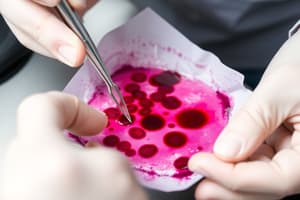Podcast
Questions and Answers
What should be the angle at which the spreader slide is pushed to create a smooth smear?
What should be the angle at which the spreader slide is pushed to create a smooth smear?
- 50-60°
- 70-80°
- 30-40° (correct)
- 10-20°
A good blood smear should touch the edges of the slide.
A good blood smear should touch the edges of the slide.
False (B)
What is the purpose of allowing the blood film to air-dry completely before staining?
What is the purpose of allowing the blood film to air-dry completely before staining?
To ensure proper staining and microscopic observation.
The blood drop should be approximately ____ mm in size when preparing a smear.
The blood drop should be approximately ____ mm in size when preparing a smear.
Match the blood smear characteristics with their descriptions:
Match the blood smear characteristics with their descriptions:
What is a common cause of a poor blood smear?
What is a common cause of a poor blood smear?
Rouleaux formation refers to RBCs clumping together like stacks of coins.
Rouleaux formation refers to RBCs clumping together like stacks of coins.
What temperature should the blood be warmed to in order to correct cold agglutinin before making a smear?
What temperature should the blood be warmed to in order to correct cold agglutinin before making a smear?
Failure to keep the spreader slide at a __________ angle with the slide can result in a poor blood smear.
Failure to keep the spreader slide at a __________ angle with the slide can result in a poor blood smear.
Match the following causes of poor blood smear with their descriptions:
Match the following causes of poor blood smear with their descriptions:
Flashcards
Blood smear preparation
Blood smear preparation
A technique for spreading a small drop of blood on a glass slide to create a thin film for microscopic examination.
Proper smear characteristics
Proper smear characteristics
A good blood smear is thick at one end, gradually thins out to a smooth edge (feather or tongue shape), covers about two-thirds of the slide, and doesn't touch the edges.
Smear spreading angle
Smear spreading angle
The angle at which the spreader slide is dragged across the blood drop affects the smear's thickness. A steeper angle creates a thicker smear.
Blood smear speed
Blood smear speed
Signup and view all the flashcards
Blood drop size
Blood drop size
Signup and view all the flashcards
Poor blood smear distribution
Poor blood smear distribution
Signup and view all the flashcards
Causes of poor blood smear
Causes of poor blood smear
Signup and view all the flashcards
Cold agglutinins
Cold agglutinins
Signup and view all the flashcards
Lipemia
Lipemia
Signup and view all the flashcards
Rouleaux
Rouleaux
Signup and view all the flashcards
Study Notes
Blood Smear Preparation
- Smears are made by placing a drop of blood on a clean glass slide and spreading it with another glass slide at an angle.
- The slide is stained and viewed microscopically.
- Proper smear preparation needs clean slides, and a proper sized blood drop.
Procedure
- Place a 2-3 mm drop of mixed whole blood approximately 1 cm from the right edge of the frosted area of the slide.
- Hold a spreader slide between your thumb and forefinger of your right hand.
- Place the spreader slide onto the slide, in front of the blood drop.
- Pull the spreader slide back until it touches the blood drop.
- Spread the blood by capillary action to near the edges of the slide.
- Push the spreader slide forward at a 30-40° angle, using a rapid, even motion. Only use the weight of the slide, do not press down. Spread the blood quickly; otherwise cell distribution will be uneven.
- The blood will create a thin film in the shape of a bullet or tongue, with a feather-edged border.
- Label the frosted edge with patient information (name, ID#, date.)
- Allow the smear to air dry completely before staining.
Characteristics of a Good Smear
- Should be thick at one end and taper to a smooth rounded feather edge or tongue shape.
- The smear should occupy about ⅔ of the slide area.
- Should not touch the edges of the slide.
- Should be free of margins, apart from the area of application.
Factors Affecting Smear Quality
- Time: Immediate spreading after placing the blood sample is critical.
- Angle: The angle of the spreader slide influences the smear's thickness; greater angles result in thicker, shorter smears.
- Blood drop size: A proper blood drop size is essential for uniform spreading.
- Speed: Rapid, even motion is required when spreading the blood.
- Hematologic factors: If hematocrit is high, use a smaller angle; if it's low, use a larger angle during spreading.
Issues with Smears
- Poor smear: Causes include blood drop too large or too small; jerky spreader motion; failure to keep the spreader and slide in contact; incorrect angle; failure to fully spread the blood; dirty or chipped slides;
- Contamination: (slides contaminated with fat, grease, or water-contaminated methanol).
- Biological factors:
- Cold Agglutinins: RBCs clump together; warm the blood before remaking smear.
- Lipemia: Holes appear in the smear; cannot be corrected.
- Rouleaux: RBCs stack like coins; cannot be corrected.
Common Causes of Poor Quality Smears (List)
- Drop of blood is too large or too small
- Jerky spreader motion
- Failure to keep spreader edge against slide
- Failure to keep spreader at a 30° angle
- Failure to fully push the spreader across
- Irregular spread (ridges, long tails)
- Dirty or chipped slide
- Dusty slide
- Holes in the smear
- Cellular changes due to delay in fixing, inadequate fixation time, or methanol contaminated with water.
Studying That Suits You
Use AI to generate personalized quizzes and flashcards to suit your learning preferences.




